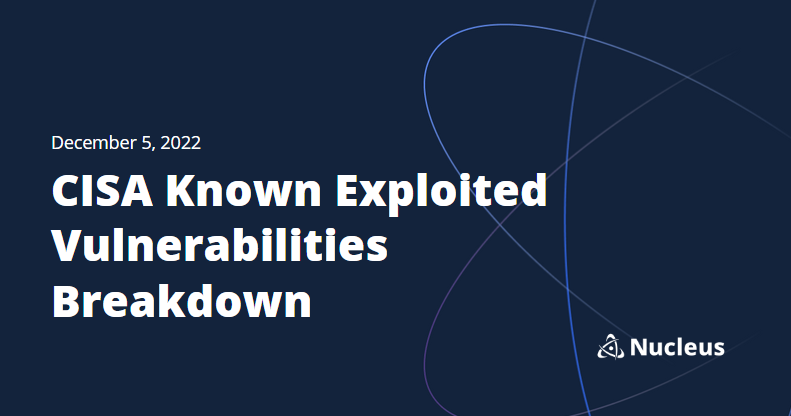December 5 CISA KEV Breakdown | CVE-2022-4262 | Chrome Type Confusion

December 5 – 1 New Vuln | CVE-2022-4262
In this CISA KEV Breakdown, CISA has added CVE-2022-4262, a type confusion vulnerability in Chrome’s V8 Javascript engine confirmed to have existing exploitation in the wild by Google on versions before 108.0.5359.94 on Mac, Linux, and Windows.
wpDataTable with provided ID not found!Notable Vulnerability Additions
CVE-2022-4262 | Google Chrome Type Corruption
Disclosed to Google by Clement Lecigne of Google’s Threat Analysis Group (TAG) on the 29th of November, a type confusion flaw of type CWE-843 exists in Google Chrome’s V8 Javascript engine that can result in heap corruption. Google released an update to Chrome on December 2, 2022. Updating to version 108.0.5359.94 or any later version of Chrome fixes the vulnerability.
To exploit the vulnerability, an attacker would need to convince a user to interact with a specially-crafted web page, indicating yet another prime candidate for actors as an initial access vector vulnerability through means of social engineering.
If these details sound familiar, the same researcher, Clement Lecigne, disclosed another Chrome vulnerability, CVE-2022-4135, to Google a week earlier, and that vulnerability also quickly was added to the CISA KEV. Chrome updates are cumulative, so if you have not yet updated Chrome to fix CVE-2022-4135, you can deploy version 108.0.5359.94 to fix both vulnerabilities. Deploying the most recent Chrome update available is a good practice.
While confirmed exploitation exists for Google Chrome, thus being mentioned in the KEV, the vulnerability does exist in the upstream Chromium project, meaning other browsers based on Chromium, such as Microsoft’s Chromium-based Edge, also have this vulnerability. Microsoft has not yet released an update to fix CVE-2022-4262. If Microsoft does not opt to create an out of band update for Edge, we can expect an update as part of the regularly scheduled December Patch Tuesday, scheduled for December 13.
Security Advisory:
https://chromereleases.googleblog.com/2022/12/stable-channel-update-for-desktop.html
http://cwe.mitre.org/data/definitions/843.html
Be sure to check out Nucleus Security’s KEV Enrichment Dashboard where we overlay vulnerabilities that are added to the catalog with intelligence from GreyNoise, exploit-prediction scoring from EPSS and lastly CVSS. You can use the data yourself and use further metrics to influence decision-making when determining risk of vulnerabilities added to the KEV.
← November 15, 2022 CISA Kev Breakdown
Click here to expand our CISA KEV Breakdown Frequently Asked Questions
- What makes for a notable addition?
- A notable addition can arise from many different characteristics. If a particular vulnerability is notable to the security community or a subset of the security community or if the EPSS score reveals notable information about the vulnerability, this can constitute further analysis. It may also be the case that a particular vulnerability shines a light on everyday users and we will highlight important information and key takeaways to ensure users and readers have easy access to actionable information.
- When is the Breakdown released?
- We aim to have our analysis of each KEV update posted within 24 hours of the time in which the Catalog is updated. See CISA’s full catalog here
- I am not bound by BOD 22-01 or federal regulations, why should the KEV concern me?
- CISA encourages all organizations to utilize the Catalog as an attribute in your vulnerability prioritization framework. Organizations looking to lessen the scope on known dangerous vulnerabilities and make a goal to remediate them can understand where they currently stand against what CISA has confirmed as exploited vulnerabilities in the wild. See CISA’s section on “How should organizations use the KEV catalog?” here.
- What is EPSS?
- EPSS is the Exploit Prediction Scoring System. It is an open, data-driven effort for estimating the likelihood (probability) that a software vulnerability will be exploited in the wild. See the EPSS home page on FIRST for more information here.
- What is the difference between EPSS probability and EPSS percent?
- EPSS probability is the risk calculated by the model when determining the perceived threat of the vulnerability itself. Percentage is a relative comparison of the rest of the CVEs within the given sample. While the probability only changes upon refreshing the results from the model, the percentage can change purely based on the CVE sample given. In the case of the Breakdown, we use the percentage given by the pool of all CVEs with given EPSS data. Scores may vary post-release of the post given new information about the vulnerabilities and their perceived threat. For more information on applying and understanding EPSS data, see this article on the FIRST website, as well as their FAQ page.
- What is GreyNoise?
- GreyNoise is a platform that collects, analyzes, and labels data on IPs that scan the internet and saturate security tools with noise. Through their sensor network, GreyNoise observes vulnerability exploitation attempts for vulnerabilities that are exploited in the wild over the Internet. These are arguably vulnerabilities that should be at the very top of your priority list to remediate.
- Why are GreyNoise exploitation attempts only observed on ~20% of KEV vulnerabilities?
- Exploitation of many vulnerabilities in the CISA KEV will not be observed for many reasons that GreyNoise does a good job of explaining in this post. For example:
- The vulnerability may not be remotely exploitable
- Vulnerability exploitation may require authentication (and result in privilege escalation)
- The impacted software may not be exposed to the internet
- Mass scanning/exploitation is not occurring yet
- Exploitation of many vulnerabilities in the CISA KEV will not be observed for many reasons that GreyNoise does a good job of explaining in this post. For example:
See Nucleus in Action
Discover how unified, risk-based automation can transform your vulnerability management.






























